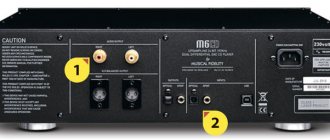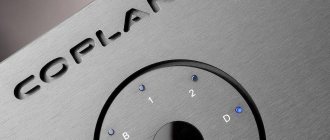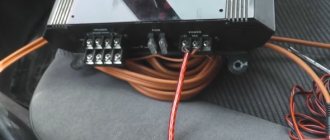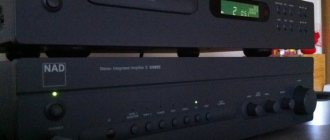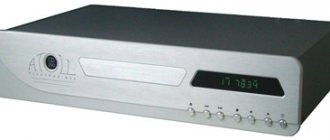Ole Moller, founder and chief designer of the Danish company Copland, in a recent interview with our magazine said that he never tried to get the so-called. tube sound. Its goal is the accuracy of music reproduction.
In general, the myth about tube sound is very tenacious. It goes back to the distant past, when amplifiers were mostly single-ended, with weak power supplies and puny output transformers. Nowadays, it is quite possible to create a good-sounding tube device that can work even with insensitive acoustics. However, this is not as simple as it seems; you need to have quite specific knowledge and experience. The company has been designing amplifiers for over forty years, so its employees have a lot of experience.
The CTA405 integrated amplifier is made in the traditional Copland style, which, as Moller himself says, can be considered the result of Protestant Puritanism, on which Scandinavian culture is based. As you can see in the photo, the front panel is strictly symmetrical. Two knobs with recessed rotating scales - volume and input selector, next to them are Tape (recording control) and Standby buttons. In the center of the composition is a round IR receiver window with a ring of LEDs that indicate which input is currently selected. The amplifier can also be controlled using a small standard remote control.
The amplifier is designed to connect up to five analog sources, incl. LP player with MM head. All connectors, including acoustic WBT, are gold-plated.
The phono stage, like the rest of the circuit, is built on tubes. The input stages are similar to those used in the CTA305 preamplifier - after the input switch, the signal goes to a buffer with a low output impedance and its own power supply, and only from it is fed to the motorized volume control. Due to this, the influence of interconnect cables on high-impedance input circuits is eliminated.
For push-pull output stages, 6550 tetrodes, which are very popular among developers, are selected, connected with a fixed bias according to an ultra-linear circuit. The output power of each channel is 50 W, regardless of the load resistance, and up to 25 W the amplifier operates in class A. The manufacturer guarantees trouble-free operation of the lamps for 4000 hours.
Thanks to the high quality output transformers, which are manufactured to Copland specifications by the best specialists in the field, the circuit was highly linear even without feedback. By introducing a common feedback depth of 18 dB, it was possible to further reduce distortion and improve load damping. This is what ultimately allows the CTA405 to control modern speakers that love high current.
Actually, the editorial Monitor Audio Gold Reference 20 is just like that, so we didn’t make any concessions to the amplifier. In terms of sound energy, it is not inferior to its transistor counterparts, and in terms of harmonic resolution it can surpass most of them. The CTA405 has a fairly powerful lower register, in which neither monotony nor loss of bass structure is noticeable. There is a lot of musical information both in the mid-frequency range and in the upper range. The only thing is that at high volumes a slight coloration appears in the upper middle, indicating an increase in distortion. Which, by the way, is confirmed by our measurements (see the subsection “Measure 7 times”). There was absolutely nothing more to complain about. The amplifier builds a three-dimensional stage with precise positioning of virtual sources, and this indicates a competent design with perfect phase matching of the channels. The symphony orchestra takes on an almost real scale with an impressive richness of timbres. If in this case we talk about the advantages of tube sound, then we can note close attention to the smallest details, which has nothing to do with increased contrast, which quickly tires the ear. Here you hear everything and enjoy it. Another noteworthy aspect is the open, unpressed sound in the lower mids, with clearly discernible reverbs and natural decays, and without feeling relaxed or drawn out in attack. The acoustics breathe freely, they are not overdamped and at the same time accurately convey the rhythmic structure of the music. This combination of, in general, formal parameters gives the sound picture realism, since attention is not distracted by fixing any inconsistencies or simplifications. The CTA405 has no obvious genre preferences, but like any tube amplifier, it is especially good at vocal parts and recordings of acoustic instruments. It is a rare transistor integrated circuit capable of such clarity and naturalness in the transmission of tonal shades.
Copland CTA 405
Manufacturer: Copland (Denmark)
www.copland.dk
Bulbs: 4 x KT88, 2 x 12BH7, 3 x E83CC, 2 x 6922 || Output power at load resistance of 8 and 4 Ohms: 2 x 50 W || SOI: < 0.4% || Signal-to-noise ratio (IHF-A): >-90 dB || Frequency response (-3 dB): 5 Hz - 100 kHz || Sensitivity for Line/Phono inputs: 350/3.5 mV || Line/Phono Input Impedance: 33/47 kOhm || Maximum power consumption: 250 VA || Dimensions: 430 x 185 x 390 mm || Weight: 25 kg || Price: 150623 rub.
let's take a look inside
Almost the entire amplifier, except for the phono stage, power and output transformers, is mounted on a common printed circuit board. The range of tubes is international: 42-watt 6550 beam tetrodes and Russian-made 12AH7 Electro Harmonix drivers, dual pre-amp triodes - E88CC Edicron (England) and E83CC JJ Electronocs (Slovakia). The quiescent current of each output lamp is adjusted individually. Judging by the number of taps from the primary winding, the output stages are made according to an ultra-linear circuit, combining the advantages of triode and pentode connection.
A phono stage board with four double triodes is installed on the rear wall, near the input connectors. On the front panel there is an indication and control board with a processor and a quartz resonator.
The power transformer is a torus with an internal shield, the impressive outputs are wound on impregnated W-iron, the thickness of the set of plates is 40 mm.
The power filter is built on two 500-volt capacitors 820 and 220 uF. The signal circuit uses exclusively Kemet (RIFA) PHE 426 film capacitors.
- MUSIC WE LISTENED TO
- 1. "Whiskey&Blues". InAkustik, Reference Sound Mastering, 2009
- 2. Terry Evans, “Puttin' It Down.” Audioquest Music/JVC, XRCD 1995
- 3. “Tutti! Orchestral Sampler". 24 bit HDCD Reference Recordings, 1997. 24-bit recording
- COMPONENTS
- CD player Primare CD-22
- Speaker systems Monitor Audio Gold Reference 20
- Cables:
- — RCA Musical Wire Cadence Signature interconnects
- — acoustic Cardas Clear Sky Banana 3 m
- — power Physics Style PW-Reference, Musical Wire Cadence Signature
COPLAND 405 or COPLAND 405A
Yes, you have quite a few “cockroaches” of your own!)))) True, all of them do not relate to the main criteria for choosing an amplifier, that is, to the nature of the sound of the amplifier and its compatibility with your speakers and other components of the audio system.
In addition, the “factor” of your musical preferences and understanding of the nature of the sound of the tract is very important. And all these factors in choosing a model and brand are much more important for the final “sound” result than those “cockroaches” that you listed above...
Among other things, the presence of a phono stage is the same thing with variable requirements, and an external phono stage of good quality and from a completely different brand can give the end result many times more interesting than anything built into the amplifier.
The presence of a remote control, this “little thing”, is a controversial thing, because many brands consider it “harmful” in terms of its impact on sound quality...
As for “made in”, everything is completely ambiguous, because the amplifier assembled in the USA will be “international” in its essence, because the components in it can be from all parts of the world... And this can be connected not only with World Globalization and integration, namely with the developer’s “vision” of the “sound character” of a given model, etc., etc....
Among other things, your budget is far from unlimited to be “too capricious” in terms of all the above points, because, let’s say, the labor of one working unit in China and the USA and the taxation system are two completely different things that will ultimately SIGNIFICANTLY influence the final cost of the product! But the most important thing is not even this, but the fact that it is not at all a fact that you have a guarantee that in America, for example, a random “illegal emigrant” from Mexico, etc., will not work on the assembly line, and at the same time in China the device will be assembled by “Uncle Liao” in the back street of Hun-sun-chai...))))
And the most important thing in choosing any component is what sound it will provide in your combination, and here I would not “stop” in choosing only one model and only one brand!!!!
I would add a couple more models to your list, although they do not have built-in phonics... This is the American Cary Audio SLI-80, one might say a legend of the company's integrated amplifiers, hand-assembled in the USA, with your basic requirements...
Perhaps I would also add the Ayon Audio models Scorpio and Spirit. And I would look towards tube integrated circuits, also at the American company Audio Research…. True, the same Keri audio costs significantly more than Copland-405a. And from Aion Audio, I would pay special attention to the amplifier models with tube equipment on the KT-120 or KT-150 and of course on their older monster amplifier Triton, also on the KT-120 or 150... This monster will “pump up” any complex acoustics and will cope with the dubbing of a decent-sized hall...
But, you should definitely listen to everything I’ve suggested with your speakers and source in order to understand which amplifier suits you best in terms of sound presentation, otherwise there’s no way to make the right choice!
I forgot to tell you the main thing that almost all of these brand amplifiers are built on our domestic tubes, so if you have an American amp, it will have our tubes in it...
Amplifier Copland CTA 405
Fortunately, despite its advanced age, tube technology does not lose its relevance either among music lovers or specialized manufacturers. The production of both radio tubes themselves and equipment based on them continues. It is gratifying to realize that in the first case, the lion's share of world production is concentrated in Russia, although the customers are mainly foreign companies. Thus, the famous American company Electro-Harmonix, known for its accessories for electric guitars, makes lamps for guitar amplifiers at the facilities of the Reflector receiving and amplifying lamp plant in Saratov. The Svetlana production association in St. Petersburg also does not reduce the volume of production of radio tubes, most of which are shipped for export.
Tube components for stereo systems are not mass produced; most often they are produced by small audio studios. And although the product range of such companies cannot boast of dozens of positions, each model receives maximum attention and love from the developers.
The Danish company Copland is a striking example of such an atelier, whose history goes back more than 30 years. It specializes in the production of electronic components for stereo systems, which in most cases are based on tube circuitry. Vacuum devices are not used only in the CDA 825 CD player. In addition, the Copland catalog contains tube preamplifiers STA 305 and CVA 306 (the latter is a rather exotic six-channel preamplifier, aimed at working in home theaters and multi-channel high-resolution music systems ), two-channel power amplifier STA 506 and stereo integrated amplifier STA 405, which ended up in the laboratory of our magazine.
When you first meet the Copland STA 405 amplifier, you will never suspect a hot inside. Unlike most of its competitors, which sport an original design with exposed bulbs, this model is clad in a quite familiar rectangular steel case, and only its considerable height, due to the size of the output tubes and transformers, hints that not everything here is so obvious. From a practical point of view, such a solution has undeniable advantages - the device is easily built into a rack, and the completely closed case reliably protects delicate internal parts. Although it will still require a separate shelf in the rack - we would not recommend placing other system components on top of it, since, like any tube amplifier, the STA 405 has a very hot temper - and in the literal sense of the word.
To enjoy the inner beauty of the device, you will have to remove the top cover. And there is something to see there! First of all, you pay attention to three large transformers. The power supply uses a large toroidal transformer from the Danish company Noratel, and the two outputs, which largely determine the voice of any tube amplifier, are of our own production; they are made on W-shaped cores and have separate outlets for connecting acoustics with a nominal impedance of 4 and 8 Ohms. We note with satisfaction the very careful installation of all components and a careful approach to their location inside the case.
A nice bonus for the buyer of the Copland STA 405 will be the built-in phono stage for working with MM or MC heads with high output. Moreover, this is not a single-chip solution inserted into an integrated amplifier for show, but a full-fledged unit mounted on the rear wall of the case and created on four lamps - a pair of double triodes ECC83S (12AX7) and two double triodes E88CC (6922). Probably, if you take the trouble to select an external phono stage, you can achieve better sound quality, but even in this case, the Copland STA 405 will give you a delay in finding a suitable option, providing an already existing built-in unit of a fairly high class.
The preliminary amplification stages here are the same as in the Copland STA 305 preamplifier. They are organized on two Electro-Harmonix 12BH7 tubes, manufactured in Saratov, and one ECC83S. The output amplifier stages use four powerful Russian-origin 6550EN pentodes from the same Electro-Harmonix, operating in ultra-linear mode, which guarantees high output power combined with low distortion.
In the same vein, preference is given to a push-pull amplifier operating circuit. At the same time, up to approximately half the power, the output tubes operate in pure class A, providing exceptional sound quality. The design uses film resistors and polypropylene film capacitors from the American company Jamicon. High-quality Axicom relays were used for switching inputs.
The appearance of the model corresponds well with the luxurious filling. In the center of the facade, in the form of a thick polished aluminum plate, the company name is cut out with a milling cutter. The front panel design is completely symmetrical. In the middle there is a round infrared sensor for the remote control, around it there are LED indicators of the active input and the amplifier turning on, on the right and left there are small buttons for switching the amplifier to Standby mode and switching the through channel of the tape recorder. In general, the combination of modern functionality and old-fashioned capabilities gives the device a special charm. A motorized volume control for controlling gain from the remote control is adjacent to the input/output for connecting a tape recorder with a through channel (the Tare button on the front panel just switches these modes). I wonder how many Copland STA 405 buyers still have such a rarity in their system?
The most noticeable elements on the facade are the volume control knobs (on the right) and the input selector (on the left). And if the input switch is completely electronic and is implemented on a pulse switch, and to activate the next input you need to make two clicks, which at first seems unusual, then the volume control here is honest - on a variable resistor with a servo drive.
Despite the classic tube circuitry, Copland STA 405 is a completely modern component. There are many little things in it that you rarely see in lamp technology. For example, the included remote control with a rectangular aluminum body is universal and allows you to control not only the amplifier, but also the CDA 825 CD player. And the Standby mode available here is practically never found in tube amplifiers, although it is not technically possible to implement remote power supply control special problem. At least for a tube amplifier this task is no more difficult than for a transistor one. Accordingly, the main power switch is located on the rear wall of the case - you won’t have to use it so often. There you can also find a 12 V trigger output for organizing general control of the music system. Such capabilities are an attribute of smart home technology.
The model's switching arsenal includes four line inputs on RCA connectors, an input and output for connecting a tape recorder, a separate pair of Phono input connectors with a screw ground terminal, and six screw acoustic terminals for connecting speakers with a nominal impedance of 4 and 8 Ohms. The amplifier, unfortunately, does not have balanced switching, although, say, the only CD player in the company’s range, the Copland CDA 825, is equipped with XLR outputs. However, there is no balanced switching even in the Copland STA 305 preamplifier, so there is no need to talk about any disadvantages of the integrated solution.
A good tube amplifier differs from its other brethren by combining the advantages of tube sound with the positive features of transistor devices. For example, if it is possible to expand the frequency range beyond the usual boundaries of 20 Hz - 20 kHz, reduce distortion to an unconditionally acceptable level, achieve a damping coefficient above several units and at the same time preserve the warmth and airiness of tube technology, and combine the softness of sound with the dynamic delivery of energetic moments of the soundtrack, then the developers can safely chalk up the victory.
Copland STA 405 became just such a triumph of Danish engineers. Even with our PMC OBli laboratory speakers, which are not the easiest for an amplifier, it demonstrated excellent dynamics and a large-scale sound stage. Compositions of different musical genres sounded extremely comfortable and airy, without losing either rhythm or drive. The bass part of the operating range was elastic and had a clearly defined relief. The information-rich symphonic works performed by a large symphony orchestra were legible and filled with the smallest details. Masterful rendering of piano timbres and careful handling of vocals in jazz recordings were combined with the ability to confidently maintain rock and roll rhythm and enthusiasm. And only in the most energetic tracks did a tendency to soften the attack sometimes slip through. However, in the case of a tube amplifier, this feature can hardly be considered a disadvantage. It is important that in energetically saturated places the musical canvas still remained amazingly detailed. The trebles were worked out perfectly, and the smallest overtones were discernible in the sound of the cymbals. Thanks to these properties, the amplifier created a three-dimensional virtual scene with precise localization of sound sources.
However, the real revelation was the built-in phono stage. Above, while studying the internal architecture of the Copland STA 405, we have already suggested that this block is not present in the design for formality at all. The listening results not only confirmed this, but suggest that the built-in phono preamplifier is quite capable of competing with individual devices at half the cost of the amplifier itself. So for vinyl lovers who have not yet acquired the necessary amount of appropriate equipment, it makes sense to pay very close attention to the Copland STA 405.
